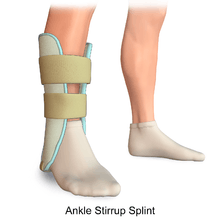Splint (medicine)
A splint is a device used for support or immobilization of a limb or the spine. It can be used in multiple situations, including temporary immobilization of potentially broken bones or damaged joints and support for joints during activity.
Uses

- By the emergency medical services or by volunteer first responders, to temporarily immobilize a fractured limb before transportation;
- By allied health professionals such as occupational therapists, physiotherapists and orthotists, to immobilize an articulation (e.g. the knee) that can be freed while not standing (e.g. during sleep);
- By athletic trainers to immobilize an injured bone or joint to facilitate safer transportation of the injured person; or
- By emergency room (ER) physicians to stabilize fractures or sprains until follow-up appointment with an orthopedist.
Commonly used splints

- Sugar Tong - Used for the forearm or wrist. They are named "sugar-tong" due to their long, U-shaped characteristics, similar to a type of utensil used to pick up sugar cubes
- Ulnar Gutter - Used for the forearm to the palm
- Volar Wrist Splint - Used for the wrist
- Thumb Spica - Used for the thumb
- Posterior Lower Leg
- Posterior Full Leg
- Posterior Elbow
- Finger Splints - Used for the fingers
- Ankle Stirrup - Used for the ankles
- Wrist/arm splint - Used for the wrist or arm
- Nasal splint
Assisted cough technique
Commonly used after surgery to provide support to an incised area and decrease pain on coughing.
While the patient attempts to cough the area is braced by the patient (or assistant) using pillow, folded blanket or extended hand placed over the incision.
Gentle pressure is applied for bracing only during the attempt to cough.
Origins
Different forms of the splint have been used sparingly throughout history; however, the splint gained great popularity as a medical device during the French and Indian War. Generally consisting of two small wooden planks, the splint was commonly tied around the fracture with rope, cloth, or even rawhide during frontier times in American history. To this day, the splint is commonly used to secure small fractures and breaks. (See, for example, Henry Gassett Davis.)
See also
- Spica splint
- SAM Splint
- Traction splint
- Vacuum splint
- Cervical collar
- Extrication splint (KED, Kendrick's extrication device)
- Long spine board
- Orthopedic surgery
- Buddy wrapping
- PASG (Pneumatic Anti-Shock Garment)